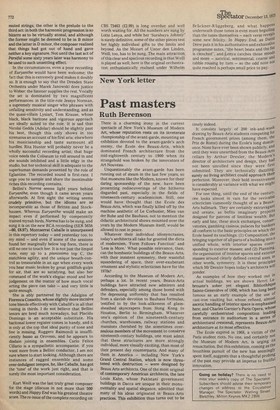New York letter
Past masters
Ruth Berenson
There is a charming irony in the current spectacle of New York's Museum of Modern Art, whose reputation rests on its inveterate championship of the avant-garde, mounting an exhibition devoted to the avant-garde's arch enemy, the Ecole des Beaux-Arts, which dominated French architecture from the mid-eighteenth century to 1900 when its strangehold was broken by the innovators of Art Nouveau.
Unquestionably the avant-garde has been running out of steam in the last few years, so that museums like the Modern, known for their daring sponsorship of the new, have been presenting rediscoverings of the hitherto disgarded past, especially in the fields of nineteenth-century academicism. Still, one would have thought that the Ecole des Beaux-Arts, which was finally killed off by the machine aesthetic of Le Corbusier, Mies van der Rohe and the Bauhaus, not to mention the didactic architectural shows mounted over the years by the Modern Museum itself, would be allowed to rest in peace.
Whatever their individual idiosyncrasies, today's architects all take for granted the dicta of modernism, 'Form Follows Function' and 'Less is More.' What possible relevance, then, can the bombastic buildings of the Beaux-Arts, with their insistent symmetry, their wasteful squandering of space, their over-exuberant ornament and stylistic eclecticism have for the 1970s?
According to the Museum of Modern Art, perhaps a lot. In recent years, Beaux-Arts buildings have attracted new admirers and defenders, especially among those bored with the depressing uniformity that has resulted from a slavish devotion to Bauhaus formulae, testified to by the look-alikeness of glasssheathed skyscrapers from Hong Kong to Houston, Berlin to Birmingham. Whatever one's opinion of the nineteenth-century churches, warehouses, railway stations and mansions cherished by the sometimes overzealous members of the movement to conserve nineteenth-century buildings, one must admit that these structures are more strongly individual, more visually exciting, than most of their present day counterparts. And many of them in America — including New York's Grand Central Station, which is now threatened with destruction — were designed by Beaux Arts architects. One of the most original of contemporary American architects, the late Louis Kahn, whose Pakistani government buildings in Dacca are unique in their monumentality and spatial elegance, admitted that many of his ideas originated in Beaux-Arts practices. This exhibition thus turns out to be timely indeed.
It consists largely of 200 ink-and-wash drawing by Beaux-Arts students competing for French government prizes (among them, the Prix de Rome) during the Ecole's long dominance. None have ever been shown publicly, and until they were unearthed from the Beaux-Arts cellars by Arthur Drexler, the Modern's director of architecture and design, they had not been unrolled since they were first submitted. They are techniCally dazzling; surely no living architect could approach their perfection. Moreover, their bold inventiveness is considerably at variance with what we might have expected. For one thing, until the end of the centurY, one looks almost in vain for the revivalist eclecticism commonly thought of as a BeauxArts hallmark. They are certainly extravagant and ornate, as befits imaginary projects designed for patrons of limitless wealth. nut early and late, these stock exchanges, conser" vatories, gambling casinos, palaces for bankers all conform to the basic principles on which the Ecole based its teachings: (1) Composition, the bringing together of all parts of a building into a unified whole, with interior spaces corresponding to exterior masses; and (2) Planning, the organisation of interior spaces and exterior masses around clearly defined central axes, in other words, symmetry. It is these principles which Mr Drexler hopes today's architects will ponder. As examples of how they worked out in actual buildings, we are shown Henri La° brouste's sober yet elegant Bibliotheque Sainte-Genevieve of 1850, which has long been famous as an early example of the use of cast-iron vaulting but whose refined, almost, ascetic handling of interior space is emphasise° here; and Charles Garnier's Paris Opera, whose carefully orchestrated composition leading from entrance to auditorium in a series of architectural crescendi, represents Beaux-Arts architecture at its most effective.
The Ecole expired in 1968, a victim of the Paris student riots. No one, and certainlY nnt the Museum of Modern Art, is urging itS resuscitation. But this exhibition, coming as the breathless pursuit of the new has seeminglY spent itself, suggests that a thoughtful probing of the past may provide an impetus to fruitful innovation.
Going on holiday? There is no need tp miss your weekly copy of The Spectator.. Subscribers should advise their temporary changes of address to the Circulation Manager, The Spectator, Watling Street, Bletchley, Milton Keynes M K2 2BW

































 Previous page
Previous page